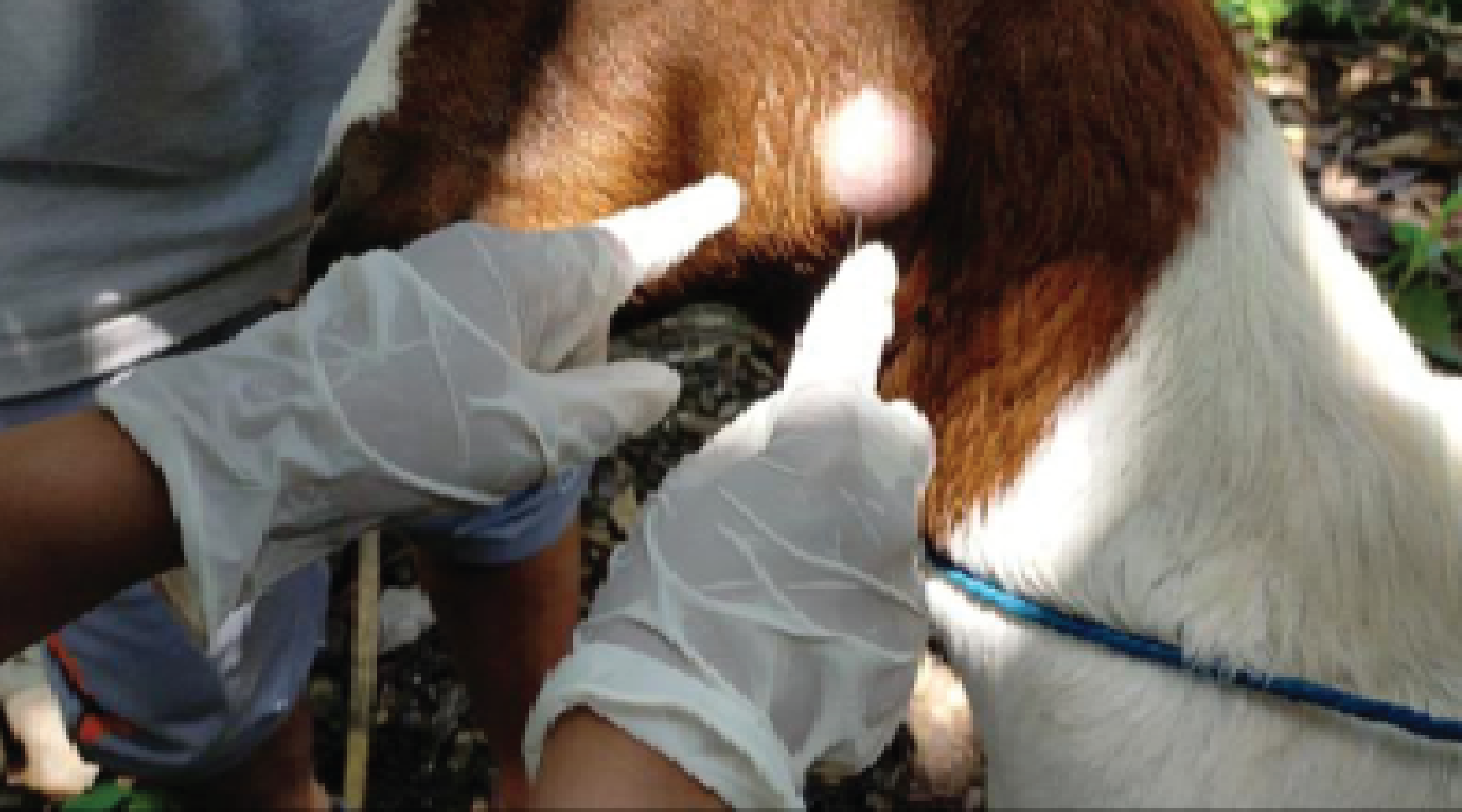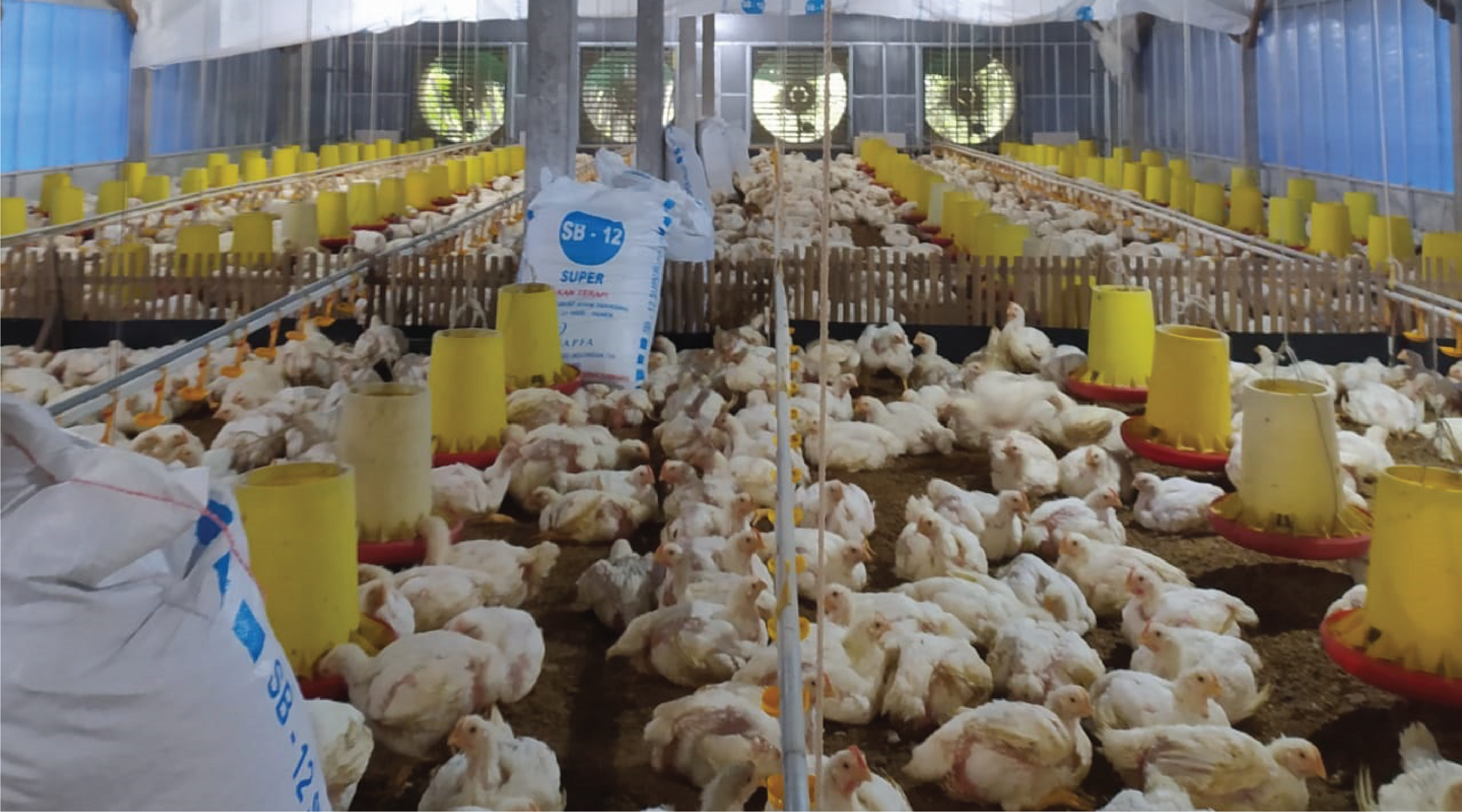Detection of Leptospiral Antibodies in Rodents and Shrews in Human Residence Vicinity in Kilwa District: A Potential Public Health Risk

Downloads
Background: Leptospirosis is a worldwide neglected zoonotic infection that affects both humans and animals in tropical and subtropical countries. Purpose: The objective of this study was to determine the presence of leptospiral antibodies in rodents and shrews, as evidence of public health threat. Method: Sera from 202 rodents and shrews were prepared and tested against five live antigens to detect leptospiral antibodies by using microscopic agglutination test. Leptospiral serovars commonly reported in Tanzania namely; Sokoine, Pomona, Hebdomadis, Lora, and Grippotyphosa were used in this study. Face-to-face interviews about cause, clinical signs, transmission, treatment and risk practices were conducted. Results: The overall prevalence of leptospiral antibodies in rodents and shrews was 14.36% (95% CI:0.0983-0.1996), whereby mastomys natalensis was a more predominant positive host species. Serovar Sokoine was more prevalent compared to other tested serovars. The antibody titers obtained in this study ranged from 1:20 to 1:80, which suggests a long-standing exposure of rodents and shrews to different leptospiral serovars. Awareness of respondents about leptospirosis was below 50% in all aspects of enquiry. Conclusion: Given the human economic activities and the ecology of rodents and shrews in study area, the findings of this study suggest a public health threat. Therefore, rodents and shrews control should be encouraged but also public and institutional efforts to prevent outbreaks are recommended.
Alinaitwe, L., Kankya, C., Namanya, D., Pithua, P., and Dreyfus, A., 2020. Leptospira Seroprevalence Among Ugandan Slaughter Cattle: Comparison of Sero-Status With Renal Leptospira Infection. Frontiers in Veterinary Science, 7(106), 1-7.
Allan, K.J., 2016. Leptospirosis in Northern Tanzania: Exploring the Role of Rodents and Ruminant Livestock in a Neglected Public Health Problem.[Theses]. University of Glasgow. UK, 14-202.
Allan, K.J., Biggs, H.M., Halliday, J.E., Kazwala, R. R., Maro, V. P., Cleaveland, S., and Crump, J. A., 2015. Epidemiology of Leptospirosis in Africa: A Systematic Review of a Neglected Zoonosis and A Paradigm for ‘One Health in Africa. PLoS Neglected Tropical Diseases, 9(9), 1–25.
Ally, A.A., Katakweba, A.S., Machang’u, R. and Lupindu, A.M., 2023. A Leptospira Infections Among Rodents and Shrews Trapped in Public Markets in Unguja Island, Zanzibar: Untold Silent Public Health Threat. East African Journal of Science,Technology and Innovation, 4(4), 1-14.
Bates, D., Machler, M., Bolker, B., and Walkers, M., 2015. Fitting Linear Mixed-Effects Model Using Ime4. Journal of Statistical Software, 67(1), 1-8
Bharti, A.R., Nally, J.E., Ricaldi, J.N., Matthias, M.A., Diaz, M. M., Lovett, M.A., and Vinetz, J.M., 2003. Leptospirosis: A Zoonotic Disease of Global Importance. The Lancet Infectious Diseases, 3(12), 757-771.
Biggs, H.M., Bui, D.M., Galloway, R.L., Stoddard, R.A., Shadomy, S.V., Morrissey, A.B., and Crump, J.A., 2011. Leptospirosis Among Hospitalized Febrile Patients in Northern Tanzania. The American Journal of Tropical Medicine and Hygiene, 85(2), 275 – 281.
Biscornet, L., Révillion, C., Jégo, S., Lagadec, E., Gomard, Y., Le Minter, G., and Herbreteau, V., 2021. Predicting the Presence of Leptospires in Rodents From Environmental Indicators Opens up Opportunities for Environmental Monitoring of Human Leptospirosis. Remote Sensing, 13(325), 1-19.
Boey, K., Shiokawa, K., and Rajeev, S., 2019. Infection In Rats: A Literature Review Of Global Prevalence and Distribution. PLoS Neglected Tropical Diseases, 13(8), 1–24.
Cole, J.R., Sulzer, C.R., and Pursell, A.R., 1973. Improved Micro Technique For The Leptospiral Microscopic Agglutination Test. Applied Microbiology, 25(6), 976-980.
Costa, A.C.T.R.B., Colocho, R.A.B., Pereira, C.R., Lage, A.P., Heinemann, M.B., and Dorneles, E.M.S., 2022. Canine Leptospirosis In Stray and Sheltered Dogs: A Systematic Review. Animal Health Research Reviews, 23(1), 39-58.
Costa, F., Hagan, J. E., Calcagno, J., Kane, M., Torgerson, P., Martinez-Silveira, M.S., and Ko, A.I., 2015. Global Morbidity And Mortality Of Leptospirosis: A Systematic Review. Plos Neglected Tropical Diseases, 9(9), 1-19.
Crump, J.A., Morrissey, A.B., Nicholson, W.L., Massung, R. F., Stoddard, R.A., Galloway, R.L., and Bartlett, J.A., 2013. Etiology of Severe Non-Malaria Febrile Illness In Northern Tanzania: A Prospective Cohort Study. PLoS Neglected Tropical Diseases, 7(7), 1 – 8.
Cheng, M., McCarl, B., and Fei, C., 2022. Climate Change and Livestock Production: A Literature Review. Atmosphere, 13(1), 140.
De Vries, S.G., Visser, B.J., Nagel, I.M., Goris, M.G., Hartskeerl, R.A., and Grobusch, M.P., 2014. Leptospirosis in Sub-Saharan Africa: A Systematic Review. International Journal of Infectious Diseases, 28(1), 47-64.
Ekwem, D., Morrison, T.A., Reeve, R., Enright, J., Buza, J., Shirima, G., Mwajombe, J.K., Lembo, T., and Hopcraft, J.G.C., 2021. Livestock Movement Informs The Risk Of Disease Spread In Traditional Production Systems In East Africa. Scientific Reports, 11(1), 16375.
Faine, S., Adler, B., Bolin, C., and Perlat, P., 1999. Leptospira and Leptospirosis. 2nd Ed. Melbourne: Australia Medical Science.
Goris, M.G., and Hartskeerl, R.A., 2014. Leptospirosis Serodiagnosis by the Microscopic Agglutination Test. Current Protocols in Microbiology, 32(1), 12-15.
Goris, M.G.A., Leeflang, M.M.G., Boer, K.R., Goeijenbier, M., van Gorp, E.C.M., Wagenaar, J.F.P., and Hartskeerl, R. A., 2012. Establishment of Valid Laboratory Case Definition for Human Leptospirosis. Journal of Bacteriology and Parasitology, 3(2), 1 - 2.
Halliday, J. E., Knobel, D. L., Allan, K. J., Bronsvoort, B. M. D. C., Handel, I., Agwanda, B., and Breiman, R. F., 2013. Urban Leptospirosis in Africa: A Cross-Sectional Survey of Leptospira Infection in Rodents in the Kibera Urban Settlement, Nairobi, Kenya. The American Journal of Tropical Medicine and Hygiene, 89(6), 1095–1102.
Holt, J., Davis, S., and Leirs, H., 2006. A Model of Leptospirosis Infection In An African Rodent To Determine Risk To Humans: Seasonal Fluctuations And The Impact Of Rodent Control. Acta Tropical, 99(3), 218-225.
Hassell, J.M., Begon, M., Ward, M.J., and Fèvre, E.M., 2017. Urbanization and Disease Emergence: Dynamics At The Wildlife–Livestock–Human Interface. Trends in Ecology & Evolution, 32(1), 55-67.
Ichumbaki, E.B., and Mapunda, B.B., 2017. Challenges to the Retention of The Integrity of World Heritage Sites in Africa: The Case of Kilwa Kisiwani and Songo Mnara, Tanzania. Azania: Archaeological Research in Africa, 52(4), 518-539.
Kahangwa, P.N., Kitegile, A.S., Machang’u, R.S., Mhamphi, G.G., and Katakweba, A.S., 2024. The Prevalence of Leptospira Serovars in African Giant Pouched Rats (Cricetomys spp.) from the Ngorongoro Conservation Area, Tanzania. Zoonotic Diseases, 4(1), 37-48.
Katakweba, A.A.S., 2018. Small Mammals in Fenced Houses as Source of Leptospirosis to Livestock Pets animals and Humans in Morogoro Municipality, Tanzania. Tanzania Veterinary Journal, 36, 83-88.
Kimari, M. W., 2016. A Pilot Study of Leptospira in Rodents in North-Eastern Kenya. [Dissertation]. University of Edinburgh.
Lubao, C., and Ichumbaki, E., 2022. Fishing Songs from Kilwa Kisiwani, Tanzania: A Case Study of Intangible Marine Cultural Heritage on the Swahili Coast. Journal of Maritime Archeology, 18(1), 165-195.
Machang'u, R.S., Mgode, G.F., Assenga, J., Mhamphi, G., Weetjens, B., Cox, C., and Hartskeerl, R.A., 2004. Serological and Molecular Characterization of Leptospira Serovar Kenya from Captive African Giant Pouched Rats (Cricetomys gambianus) from Morogoro Tanzania. FEMS Immunology & Medical Microbiology, 41(2), 117-121.
Machang'u, R., Mgode, G., and Mpanduji, D., 1997. Leptospirosis in Animals and Humans in Selected Areas of Tanzania. Belgian Journal of Zoology, 127, 97-104.
Majawa, C.A., Lupindu, A.M., Mhamphi, G.G., Machang’u, R.S., and Katakweba, A.A., 2023. Seroprevalence of Leptospira antibodies in rodents and shrews of Kibondo and Kakonko Districts, Kigoma region, Tanzania. Malawi Journal of Science and Technology, 15(1), 55-74.
Marková, I.S., and Berrios, G.E., 2006 Approaches to The Assessment of Awareness: Conceptual Issues. Neuropsychological Rehabilitation: An International Journal, 16(4), 439-455.
Masunga, D. S., Rai, A., Abbass, M., Uwishema, O., Wellington, J., Uweis, L., and Onyeaka, H., 2022. Leptospirosis Outbreak in Tanzania: An Alarming Situation. Annals of Medicine and Surgery, 80(1), 104–347.
Mgode, G.F., Machang'u, R.S., Goris, M.G., Engelbert, M., Sondij, S., and Hartskeerl, R.A., 2006. New Leptospira serovar Sokoine of serogroup Icterohaemorrhagiae from cattle in Tanzania. International Journal of Systematic and Evolutionary Microbiology, 56(3), 593-597.
Mgode, G.F., Machang’u, R.S., Mode, G.G., Catawba, A., Muzungu, L.S., Durnaz, L., Leirs, H., Hartskeerl, R.A., and Balmain, S.R., 2015. Leptospira Serovars for Diagnosis of Leptospirosis In Humans and Animals In Africa: Common Leptospira Isolates and Reservoir Hosts. PLoS Neglected Tropical Diseases, 9(12), 1–9.
Mgode, G.F., Mbuga, H.A., Mode, G.G., Ndonga, D., and Naima, E.L., 2014. Seroprevalence of Leptospira Infection in Bats Roosting in Human Settlements in Morogoro Municipality in Tanzania. Tanzania Journal of Health Research, 16(1), 1-7.
Mgode, G. F., Mode, G. G., Catawba, A., and Thomas, M., 2014. Leptospira Infections In Freshwater Fish In Morogoro Tanzania: A Hidden Public Health Threat. Tanzania Journal of Health Research, 16(2), 1–7.
Mgode, G.F., Mode, G.G., Massawa, A.W., and Machang’u, R. S., 2021. Leptospira Seropositivity in Humans, Livestock and Wild Animals in a Semi-Arid Area of Tanzania. Pathogens, 10(696), 1–12.
Motto, S.K., Shirima, G.M., de Clare Bronsvoort, B.M., and Cook, E.A.J., 2021. Epidemiology of Leptospirosis in Tanzania: A Review of The Current Status, Serogroup Diversity and Reservoirs. PLoS Neglected Tropical Diseases, 15(11), p.e0009918.
Murillo, A., Goris, M., Ahmed, A., Cuenca, R., and Pastor, J., 2020. Leptospirosis in Cats: Current Literature Review to Guide Diagnosis and Management. Journal of Feline Medicine and Surgery, 22(3), 216-228.
Ngugi, J.N., Fèvre, E.M., Mgode, G.F., Obonyo, M., Mhamphi, G.G., Otieno, C.A., and Cook, E.A. ., 2019. Seroprevalence and Associated Risk Factors of Leptospirosis in Slaughter Pigs; A Neglected Public Health Risk, Western Kenya. BioMed Central Veterinary Research, 15(1), 1-11.
Picardeau, M., 2015. Leptospirosis: updating the global picture of an emerging neglected disease. PLoS Neglected Tropical Diseases, 9(9), 1 – 2.
Sarkar, U., Nascimento, S.F., Barbosa, R., Martins, R., Nuevo, H., Kalafanos, I., and Ko, A.I., 2002. Population-Based Case-Control Investigation Of Risk Factors For Leptospirosis During An Urban Epidemic. American Journal of Tropical Medicine Hygiene, 66(5), 605–610.
Suwannarong, K., Soonthornworasiri, N., Maneekan, P., Yimsamran, S., Balthip, K., Maneewatchararangsri, S., Saisongkorh, W., Saengkul, C., Sangmukdanun, S., Phunta, N., and Singhasivanon, P., 2022. Rodent–Human Interface: Behavioral Risk Factors and Leptospirosis In A Province In The Central Region Of Thailand. Veterinary Sciences, 9(2), 2-21
Torgerson, P.R., Hagan, J.E., Costa, F., Calcagno, J., Kane, M., Martinez-Silveira, M.S., and Abela-Ridder, B., 2015. Global Burden Of Leptospirosis: Estimated In Terms Of Disability Adjusted Life Years. PLoS Neglected Tropical Diseases, 9(10), 1-7.
World Health Organization, 2011. Report of The Second Meeting Of The Leptospirosis Burden Epidemiology Reference Group.
Copyright (c) 2025 Authors

This work is licensed under a Creative Commons Attribution-ShareAlike 4.0 International License.
- The journal allows the author to hold the copyright of the article without restrictions.
- The journal allows the author(s) to retain publishing rights without restrictions.
- The legal formal aspect of journal publication accessibility refers to Creative Commons Attribution Share-Alike (CC BY-SA).

Journal of Applied Veterinary Science and Technology is licensed under a Creative Commons Attribution-ShareAlike 4.0 International License





























